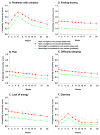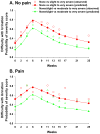Trajectories and predictors of symptom occurrence, severity, and distress in prostate cancer patients undergoing radiation therapy
- PMID: 22771128
- PMCID: PMC3463773
- DOI: 10.1016/j.jpainsymman.2011.10.020
Trajectories and predictors of symptom occurrence, severity, and distress in prostate cancer patients undergoing radiation therapy
Abstract
Context: Radiation therapy (RT) is a common treatment for prostate cancer. Despite available research, prostate cancer patients report that information about side effects is their most important unmet need. Additional research is needed that focuses on specific dimensions of the patient's symptom experience.
Objectives: The study's purposes were to evaluate the trajectories of occurrence, severity, and distress of the six most prevalent symptoms reported by patients undergoing RT for prostate cancer and the effects of selected demographic and clinical characteristics on these trajectories.
Methods: Patients completed the Memorial Symptom Assessment Scale 11 times before, during, and after RT. For problems with urination, pain, lack of energy, feeling drowsy, difficulty sleeping, and diarrhea, the trajectories of occurrence, severity, and distress were evaluated using multilevel generalized linear models.
Results: Across all three dimensions, pain, lack of energy, feeling drowsy, and difficulty sleeping followed a decreasing linear trend. Problems with urination and diarrhea demonstrated more complex patterns of change over time.
Conclusion: Although longitudinal data on pain, lack of energy, feeling drowsy, and difficulty sleeping are limited, they are highly prevalent symptoms in these patients. In addition, diarrhea becomes a significant problem for these patients over the course of RT. A number of demographic and clinical characteristics affect the trajectories of these common symptoms differentially.
Copyright © 2012 U.S. Cancer Pain Relief Committee. Published by Elsevier Inc. All rights reserved.
Conflict of interest statement
The authors declare no conflicts of interest.
Figures









Similar articles
-
Changes over time in occurrence, severity, and distress of common symptoms during and after radiation therapy for breast cancer.J Pain Symptom Manage. 2013 Jun;45(6):980-1006. doi: 10.1016/j.jpainsymman.2012.06.003. Epub 2012 Sep 29. J Pain Symptom Manage. 2013. PMID: 23026547 Clinical Trial.
-
Changes in the Occurrence, Severity, and Distress of Symptoms in Patients With Gastrointestinal Cancers Receiving Chemotherapy.J Pain Symptom Manage. 2018 Mar;55(3):808-834. doi: 10.1016/j.jpainsymman.2017.10.004. Epub 2017 Oct 17. J Pain Symptom Manage. 2018. PMID: 29051114 Free PMC article.
-
Previous chemotherapy influences the symptom experience and quality of life of women with breast cancer prior to radiation therapy.Cancer Nurs. 2012 May-Jun;35(3):167-77. doi: 10.1097/NCC.0b013e31821f5eb5. Cancer Nurs. 2012. PMID: 21760482
-
Telephone interventions for symptom management in adults with cancer.Cochrane Database Syst Rev. 2020 Jun 2;6(6):CD007568. doi: 10.1002/14651858.CD007568.pub2. Cochrane Database Syst Rev. 2020. PMID: 32483832 Free PMC article.
-
Quality of life study in prostate cancer patients treated with three-dimensional conformal radiation therapy: comparing late bowel and bladder quality of life symptoms to that of the normal population.Int J Radiat Oncol Biol Phys. 2001 Jan 1;49(1):51-9. doi: 10.1016/s0360-3016(00)01365-1. Int J Radiat Oncol Biol Phys. 2001. PMID: 11163497 Review.
Cited by
-
Parp1 promotes sleep, which enhances DNA repair in neurons.Mol Cell. 2021 Dec 16;81(24):4979-4993.e7. doi: 10.1016/j.molcel.2021.10.026. Epub 2021 Nov 18. Mol Cell. 2021. PMID: 34798058 Free PMC article.
-
Older Age, Early Symptoms and Physical Function are Associated with the Severity of Late Symptom Clusters for Men Undergoing Radiotherapy for Prostate Cancer.Clin Oncol (R Coll Radiol). 2018 Jun;30(6):334-345. doi: 10.1016/j.clon.2018.01.016. Epub 2018 Feb 17. Clin Oncol (R Coll Radiol). 2018. PMID: 29459102 Free PMC article.
-
Stress-Induced Sleep After Exposure to Ultraviolet Light Is Promoted by p53 in Caenorhabditis elegans.Genetics. 2017 Oct;207(2):571-582. doi: 10.1534/genetics.117.300070. Epub 2017 Jul 28. Genetics. 2017. PMID: 28754659 Free PMC article.
-
Symptoms predicting health-related quality of life in prostate cancer patients treated with localized radiation therapy.Fam Med Community Health. 2017 Jul 1;5(2):119-128. doi: 10.15212/FMCH.2017.0133. Fam Med Community Health. 2017. PMID: 30263893 Free PMC article.
-
Implementation Readiness and Initial Effects of a Brief Mindfulness Audio Intervention Compared With a Brief Music Control During Daily Radiation Therapy for Prostate Cancer: A Randomized Pilot Study.Glob Adv Integr Med Health. 2024 Apr 30;13:27536130241249140. doi: 10.1177/27536130241249140. eCollection 2024 Jan-Dec. Glob Adv Integr Med Health. 2024. PMID: 38694593 Free PMC article.
References
-
- Siegel R, Ward E, Brawley O, Jemal A. Cancer statistics, 2011: the impact of eliminating socioeconomic and racial disparities on premature cancer deaths. CA Cancer J Clin. 2011;61:212–236. - PubMed
-
- Eller LS, Lev EL, Gejerman G, et al. Prospective study of quality of life of patients receiving treatment for prostate cancer. Nurs Res. 2006;55:S28–S36. - PubMed
-
- Krahn MD, Bremner KE, Tomlinson G, Naglie G. Utility and health-related quality of life in prostate cancer patients 12 months after radical prostatectomy or radiation therapy. Prostate Cancer Prostatic Dis. 2009;12:361–368. - PubMed
-
- Litwin MS, Gore JL, Kwan L, et al. Quality of life after surgery, external beam irradiation, or brachytherapy for early-stage prostate cancer. Cancer. 2007;109:2239–2247. - PubMed
-
- Talcott JA, Manola J, Clark JA, et al. Time course and predictors of symptoms after primary prostate cancer therapy. J Clin Oncol. 2003;21:3979–3986. - PubMed

